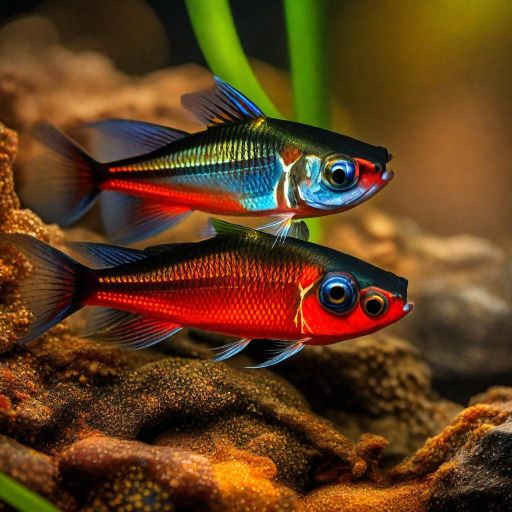Ember Tetra: Transforming Your Aquarium into a Colorful Underwater Paradise!
Introduction
Ember Tetra, scientifically known as Hyphessobrycon amandae, is a stunning freshwater fish species that hails from the upper Rio Araguaia basin in Brazil. This tiny gem of the aquarium world has gained popularity among hobbyists due to its vibrant red-orange coloration and peaceful nature.
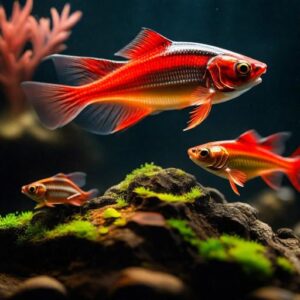
Native Habitat and Distribution
These are endemic to the clear, slow-moving streams and small tributaries of the Rio Araguaia basin in Brazil. In its natural habitat, this species inhabits densely vegetated areas with leaf litter, tree branches, and submerged roots. They thrive in warm waters that range from 75 to 82 degrees Fahrenheit (24 to 28 degrees Celsius) with a pH level of 6 to 7.
Aquarium Set-Up and Equipment
To ensure the optimal health and happiness of your Ember Tetras, it’s crucial to set up their aquarium properly. Here are key factors to consider:
Tank size and ideal environment
Ember Tetras are small fish, typically measuring around 0.8 to 1 inch (2 to 2.5 centimeters) in length. A 10-gallon (38-liter) aquarium is sufficient for a small shoal of Ember Tetras, but larger tanks provide additional swimming space and stability. It’s essential to provide plenty of hiding places through the inclusion of plants, driftwood, and rocks.

Suitable water parameters for Ember Tetra
Maintaining the correct water parameters is vital for the well-being of these fish. The ideal water temperature should be within the range of 75 to 82 degrees Fahrenheit (24 to 28 degrees Celsius), with a slightly acidic to neutral pH level of 6 to 7. Additionally, it’s crucial to keep the water hardness at a moderate level of 5 to 15 dGH.
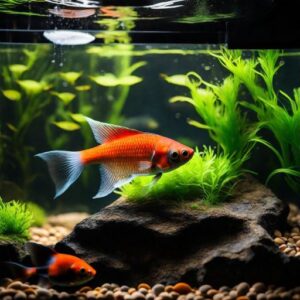
Filtration and water circulation
A good filtration system is essential to maintain water quality and provide adequate oxygenation. Tetras appreciate gentle water flow, so it’s advisable to choose a filter with an adjustable flow rate. Sponge filters and hang-on-back filters are commonly used options that provide both mechanical and biological filtration.
Lighting requirements
Tetras do not have any specific lighting requirements. However, it is recommended to provide a natural day-night cycle for your aquarium inhabitants. A low to moderate intensity LED light fixture can be used to enhance the colors of the fish and promote the growth of live plants.
Optimal placement of plants and decorations
Creating an environment with plenty of hiding spots and visual barriers is crucial for these fish. Dense vegetation, such as species of Java Moss, Microsorum, or floating plants like Amazon Frogbit, will replicate their natural habitat. Decorations like driftwood, clay pots, and rocks can also be added to provide additional hiding places and create a visually appealing aquarium.
Ember Tetra Behavior and Social Interaction
These are peaceful and sociable fish that thrive in shoaling environments. They display stunning group dynamics and prefer to be kept in small groups of at least six individuals. Keeping them in larger shoals enhances their comfort and promotes natural behavior, reducing stress and aggression.
Group dynamics and shoaling behavior
In their natural habitat, Ember Tetras form tight-knit shoals as a defense mechanism against predators. Observing this behavior in the aquarium brings out their vibrant colors and playful interactions. Maintaining a group of Ember Tetras creates a lively and captivating display, showcasing their natural tendencies.
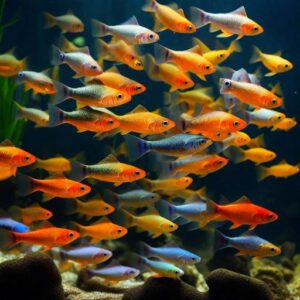
Interaction with other fish species
Ember Tetras are compatible with a wide variety of peaceful fish species, making them ideal candidates for community tanks. Popular tankmates include other small, peaceful fish like Boraras species, Dwarf Corydoras, or small Rasboras. It’s important to avoid keeping them with larger, aggressive species that may harm or intimidate the Ember Tetras.
Feeding habits and dietary requirements
Ember Tetras are omnivorous and will readily accept a variety of prepared foods. They can be fed a staple diet of high-quality flake food or small pellets designed specifically for tropical fish. Supplementing their diet with frozen or live foods like daphnia, brine shrimp, or insect larvae will help provide essential nutrients and promote their natural foraging behaviors.
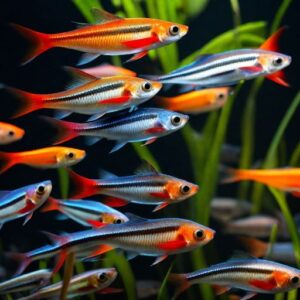
Breeding behaviors and spawning
Breeding Ember Tetras can be a rewarding experience for dedicated aquarists. To encourage breeding, setting up a separate breeding tank with similar water conditions to the main aquarium is recommended. The inclusion of fine-leaved plants, like Java Moss or spawning mops, will provide suitable spawning sites. Females will scatter their eggs among the plants, and males will fertilize them. Removing the adults after spawning is crucial to prevent them from eating the eggs.
Water Quality Maintenance
Maintaining optimal water quality is of utmost importance when caring for Ember Tetras. Monitoring and addressing water parameters and potential issues will create a healthy and thriving environment for these delicate fish.
Importance of water quality for Ember Tetra
Ember Tetras, like many other fish, are highly sensitive to water conditions. Poor water quality can lead to stress, disease, and even mortality. By consistently maintaining clean and stable water parameters, you can ensure the long-term health and well-being of your Ember Tetras.
Cycling a tank for Ember Tetra
Cycling an aquarium is a critical step in establishing a stable and healthy aquatic environment for Ember Tetras. This process involves the growth of beneficial bacteria that convert toxic ammonia into less harmful substances. Options for cycling include using bacterial additives or allowing the tank to cycle naturally with a source of ammonia. Regular testing of ammonia, nitrite, and nitrate levels will indicate when the tank is fully cycled and ready for the addition of fish.
Maintaining proper water parameters
Ember Tetras thrive in slightly acidic to neutral water conditions. Regular monitoring of temperature, pH, ammonia, nitrite, and nitrate levels is essential to ensure these parameters remain within the appropriate range. Conducting partial water changes of 20% every one to two weeks will help remove excess nutrients and maintain water quality.
Regular water testing and potential issues
Using a reliable water test kit to monitor water parameters is crucial in identifying any potential issues. Elevated ammonia and nitrite levels can be harmful to Ember Tetras, so immediate action should be taken if any signs of imbalance are detected. Overfeeding, overcrowding, or insufficient filtration can all contribute to poor water quality. Regular maintenance, observation, and testing will help prevent problems before they escalate.
Ember Tetra Diet and Nutrition
A nutritious and balanced diet is essential for the overall health and vibrancy of Ember Tetras. Providing a varied menu of high-quality foods will ensure their nutritional needs are met.
Natural diet in the wild
In their natural habitat, Ember Tetras feed on small invertebrates, insect larvae, and zooplankton. They also consume algae and plant matter, supplementing their diet with a variety of food sources readily available in their environment.
Essential nutrients and dietary requirements
To replicate their natural diet, it is important to feed Ember Tetras a combination of protein-rich foods and plant matter. A high-quality tropical fish flake or pellet food serves as a good staple diet. Additionally, offering live or frozen foods like bloodworms, daphnia, or brine shrimp will provide essential nutrients and promote their natural foraging behaviors.
Feeding strategies and recommended food types
Ember Tetras are known to be voracious eaters and will readily accept most commercially available fish foods. To vary their diet, offering occasional treats like freeze-dried or frozen foods will help replicate their natural feeding habits. Supplementing their diet with live or frozen foods should be done sparingly, about two to three times a week, to avoid overfeeding and subsequent water quality issues.
Frequency and portion sizes
Feeding Ember Tetras in small, frequent meals throughout the day is preferable over a single large feeding. Aim to feed them two to three times a day, providing an amount they can consume within three to five minutes. Feeding in smaller portions helps prevent overfeeding and minimizes waste, leading to improved water quality.
Tankmates for Ember Tetra
When selecting tankmates for Ember Tetras, it’s essential to consider their peaceful nature and small size. Compatible tankmates will help create a harmonious community aquarium.
Compatible fish species for community tanks
Ember Tetras are social fish that thrive in community environments. They peacefully coexist with other small, non-aggressive species, adding a touch of color and liveliness to the tank. Suitable tankmates include small Rasboras, Boraras species, Dwarf Corydoras, and peaceful small tetras like Neon Tetras or Ember Tetra’s close relative, the Diamond Tetra.
Aggressive and incompatible species to avoid
Due to their small size and peaceful nature, Ember Tetras are vulnerable to aggression from larger or more aggressive fish. It’s crucial to avoid keeping them with species known for their fin-nipping or territorial behavior. Aggressive cichlids or large, predatory species should be avoided to ensure the safety and well-being of Ember Tetras.
Ideal tankmate combinations
To create an ideal tankmate combination for Ember Tetras, choose peaceful species that occupy different areas of the aquarium. For example, bottom-dwelling fish like Dwarf Corydoras or small plecos can coexist peacefully with Ember Tetras, as they occupy different niches within the tank. This provides a visually appealing and balanced community aquarium.
Disease Prevention and Treatment
Maintaining a disease-free environment should be a top priority for any responsible aquarium hobbyist. Preventive measures and prompt action can help ensure the well-being of your Ember Tetras.
Common diseases affecting Ember Tetra
Like many other fish species, Ember Tetras are susceptible to various diseases, including fungal infections, bacterial infections, and parasitic infestations. Fin rot, white spot disease (ich), and velvet disease are among the most common ailments that can affect these delicate fish.
Recognizing signs of illness
Being proactive and observant is crucial in recognizing signs of illness in Ember Tetras. Common symptoms include loss of color, decreased appetite, abnormal swimming behavior, abnormal growths or lesions, or visible signs of parasites on the body or fins. Any noticeable changes in behavior or appearance warrant immediate attention and prompt action to prevent the spread of disease.
Preventative measures and regular health checks
Maintaining proper water quality and adhering to a regular maintenance routine is the first line of defense against diseases. Maintaining stable water parameters, providing a balanced diet, and avoiding overcrowding are essential preventative measures. Additionally, performing regular health checks and observing your fish for signs of abnormalities will ensure early detection of potential issues.
Treatment options for various ailments
If your Ember Tetras do fall ill, prompt treatment is crucial to their recovery. Treatment options may include the use of medications, such as antifungal or antibacterial medications, in accordance with the specific ailment identified. Consultation with a knowledgeable aquatic veterinarian or experienced fishkeeper is recommended to ensure proper diagnosis and treatment.
Ember Tetra Breeding and Reproduction
For those interested in experiencing the wonder of witnessing Ember Tetras reproduce, creating suitable breeding conditions is key.
Sexual dimorphism and identifying genders
Distinguishing between male and female Ember Tetras can be challenging. However, when ready to breed, females tend to have a plumper abdomen, while males may exhibit more intense coloration. In a group setting, males may display courtship behavior, such as chasing or flaring their fins to attract the attention of females.
Preparing a breeding tank
Setting up a separate breeding tank is essential to increase the likelihood of successful breeding. The tank should be equipped with dense vegetation, such as Java Moss or spawning mops, to create suitable spawning sites. Fine-leaved plants provide ideal locations for the female Ember Tetra to scatter her eggs.
Stimulating breeding conditions
To encourage Ember Tetras to breed, replicate their natural habitat conditions. This includes maintaining water parameters consistent with their preferences, such as a slightly acidic to neutral pH level around 6 to 7, and a temperature range of 75 to 82 degrees Fahrenheit (24 to 28 degrees Celsius). Dimming the lights and providing high-quality food and frequent water changes can also stimulate breeding.
Caring for the eggs and fry
Ember Tetras are egg scatterers, meaning that the female will release her eggs among the plants, and the male will fertilize them. After spawning, it is vital to remove the adult fish from the breeding tank to prevent them from eating the eggs. The eggs will hatch within 24 to 48 hours, and the fry can be fed infusoria or commercial liquid fry food until they are large enough to consume baby brine shrimp or crushed flakes.
Tips for Ember Tetra Enthusiasts
For those passionate about maintaining Ember Tetras, expert recommendations and tips can enhance their overall experience and success in caring for these captivating fish.
Expert recommendations for maintaining
Knowledgeable aquarists recommend keeping Ember in shoals of at least six individuals to ensure their well-being and to bring out their vibrant colors. They also advise providing a well-planted tank with plenty of hiding spots and visual barriers to replicate their natural habitat.
Creating an aesthetically pleasing Ember Tetra habitat
To create an aesthetically pleasing habitat for Ember Tetras, focus on replicating their natural surroundings. A combination of live plants, such as Java Moss, Anubias, and Brazilian Pennywort, can provide a lush, visually appealing environment. Driftwood, rocks, and leaf litter can be added strategically to create enticing hiding spots and naturalistic scenery.
Enhancing coloration and vibrancy in Ember Tetra
To enhance the coloration and vibrancy of Ember , ensure their diet is rich in carotenoids. These natural pigments can be found in high-quality foods and help intensify the red-orange hues of these fish. Providing a stress-free environment with suitable tankmates and optimal water conditions will also contribute to their overall vibrancy.
Conclusion
Ember Tetras, with their captivating red-orange coloration and peaceful nature, are an excellent choice for creating a vibrant underwater paradise in your aquarium. By understanding their origin, ideal habitat, and specific care requirements, you can provide a nurturing environment for these tiny gems of the aquatic world. Implementing proper tank setup, suitable tankmates, and maintaining water quality will ensure the long-term health and vibrancy of Ember Tetras. Whether you are a beginner or an experienced aquarist, the beauty and tranquility they bring to an aquarium make Tetras an appealing choice for any enthusiast.
Frequently Asked Questions (FAQs)
Addressing common questions about Ember Tetras will provide valuable information for both beginners and experienced fishkeepers.
What is the lifespan of Ember Tetra?
Ember Tetras have an average lifespan of 2 to 3 years when cared for properly. Providing them with a well-maintained aquarium and meeting their specific habitat requirements can contribute to their longevity.
Are Ember Tetras suitable for beginners?
Yes, these are suitable for beginners due to their hardiness and adaptability to varying water conditions. However, it is important to familiarize yourself with their care requirements and provide a suitable environment for their well-being.
How many Ember Tetras can be kept in a tank?
A shoal of Tetras should consist of at least six individuals to ensure their social well-being. In a 10-gallon (38-liter) tank, this number would be suitable. Larger tanks allow for the addition of more Ember Tetras, but it’s important to consider the overall bioload and maintain appropriate water quality.
How often should Ember Tetras be fed?
It should be fed small, frequent meals two to three times a day. Feeding them within the span of three to five minutes with an amount they can consume is advisable to prevent overfeeding and maintain water quality.
Can Ember Tetras be kept in a planted tank?
Absolutely! Ember thrive in heavily planted tanks as it closely mimics their natural habitat. The plants provide cover, hiding spots, and replicate the ideal environment for these small, lively fish.

